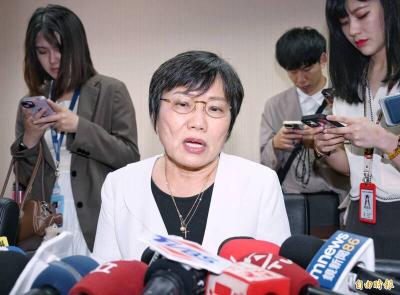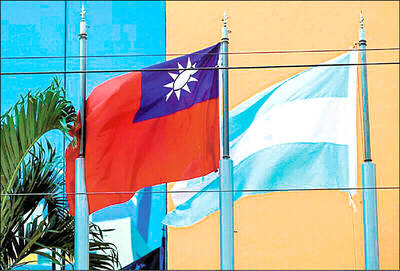Taipei Mayor Ko Wen-je (柯文哲) yesterday outlined plans for “smart and green” city development, announcing that bike paths will be laid alongside all of the capital’s major arteries.
In a speech at the Green Together City-to-City Sustainability Dialogues also attended by Taichung Mayor Lin Chia-lung (林佳龍) and Taoyuan Mayor Cheng Wen-tsan (鄭文燦), Ko outlined his vision for a “green city” characterized by zero growth in electricity consumption and usage of public transportation by 80 percent of city residents.
Ko outlined policies aimed at increasing use of public transportation, saying that new bicycle paths would be laid alongside all city roads 40m wide or more.
“Presently, we have bicycles, but we don’t have bicycle lanes,” Ko said, referring to the rapid growth of the city’s YouBike service.
Taipei Department of Transportation Commissioner Chung Hui-yu (鍾慧諭) said the city has budgeted NT$1.2 billion (US$38 million) this year for bicycle path construction costs. City plans call for quadrupling the length of city bicycle paths to 209km by 2019.
Ko also announced that the city was considering introducing a car-sharing program, as well as reforms to more closely integrate the city’s bus lines with the MRT, update bus computer systems and enable fees for bus rides to be charged based on distance.
He said the city also plans to promote green architecture and use special water-porous pavement to reduce Taipei’s urban heat-island effect.
In addition to “green” policies, Ko also announced policies for “smart” technological reform, highlighted by changes to the city’s free WiFi service.
“With more than 6,400 hot spots, Taipei Free consumes between NT$10 million and NT$20 million every year, but even I myself have trouble using the service,” Ko said.
He said that in the future, the city would merge Taipei Free into the national ITaiwan service, dropping the number of hotspots to less than 2,000, while integrating additional private hotspots operated by businesses, such as Starbucks and 711.

Chinese Nationalist Party (KMT) Chairman Eric Chu (朱立倫), spokeswoman Yang Chih-yu (楊智伃) and Legislator Hsieh Lung-chieh (謝龍介) would be summoned by police for questioning for leading an illegal assembly on Thursday evening last week, Minister of the Interior Liu Shyh-fang (劉世芳) said today. The three KMT officials led an assembly outside the Taipei City Prosecutors’ Office, a restricted area where public assembly is not allowed, protesting the questioning of several KMT staff and searches of KMT headquarters and offices in a recall petition forgery case. Chu, Yang and Hsieh are all suspected of contravening the Assembly and Parade Act (集會遊行法) by holding

PRAISE: Japanese visitor Takashi Kubota said the Taiwanese temple architecture images showcased in the AI Art Gallery were the most impressive displays he saw Taiwan does not have an official pavilion at the World Expo in Osaka, Japan, because of its diplomatic predicament, but the government-backed Tech World pavilion is drawing interest with its unique recreations of works by Taiwanese artists. The pavilion features an artificial intelligence (AI)-based art gallery showcasing works of famous Taiwanese artists from the Japanese colonial period using innovative technologies. Among its main simulated displays are Eastern gouache paintings by Chen Chin (陳進), Lin Yu-shan (林玉山) and Kuo Hsueh-hu (郭雪湖), who were the three young Taiwanese painters selected for the East Asian Painting exhibition in 1927. Gouache is a water-based

Taiwan would welcome the return of Honduras as a diplomatic ally if its next president decides to make such a move, Minister of Foreign Affairs Lin Chia-lung (林佳龍) said yesterday. “Of course, we would welcome Honduras if they want to restore diplomatic ties with Taiwan after their elections,” Lin said at a meeting of the legislature’s Foreign Affairs and National Defense Committee, when asked to comment on statements made by two of the three Honduran presidential candidates during the presidential campaign in the Central American country. Taiwan is paying close attention to the region as a whole in the wake of a

OFF-TARGET: More than 30,000 participants were expected to take part in the Games next month, but only 6,550 foreign and 19,400 Taiwanese athletes have registered Taipei city councilors yesterday blasted the organizers of next month’s World Masters Games over sudden timetable and venue changes, which they said have caused thousands of participants to back out of the international sporting event, among other organizational issues. They also cited visa delays and political interference by China as reasons many foreign athletes are requesting refunds for the event, to be held from May 17 to 30. Jointly organized by the Taipei and New Taipei City governments, the games have been rocked by numerous controversies since preparations began in 2020. Taipei City Councilor Lin Yen-feng (林延鳳) said yesterday that new measures by